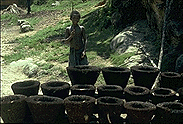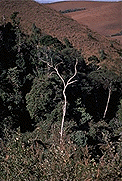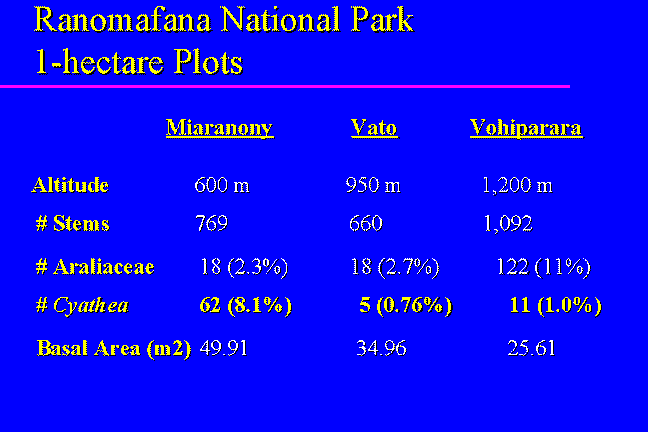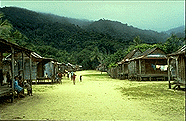

Much of Madagascar is now covered with anthropogenic vegetation, and its extent is still expanding at an alarming rate. But even Madagascar's so-called "natural" vegetation is by no means isolated from man's influence. Large areas of forest are impacted, to one degree or another, by direct human action.
For example, over-exploitation of Cyathea tree ferns is critical in many areas.

At Ranomafana National Park, results from 1-ha permanent plots show that tree ferns are now almost totally absent at Vatoharanana (950 m) and Vohiparara (1,200 m), where stumps indicate recent cutting. By contrast, tree ferns make up nearly 10% of the stems greater than 10 cm DBH at Miaranony (600 m), which has not been subjected to the pressures of over-exploitation -- or at least not yet.
Perhaps even more insidious is the kind of indirect impact humans are having. The common rat, Rattus rattus, introduced to Madagascar by seafarers, now occurs in large numbers throughout the island, even in the middle of what appears to be pristine forest (Goodman, 1995). A similar situation exists with respect to introduced ant species displacing the native ant fauna (B. L. Fisher, pers. comm.). And now, when a tree falls over in the heart of the Masoala Peninsula, in the middle of one of the country's largest remaining blocks of dense, unexplored rain forest, the opening it creates is not only colonized by native plants, but also by introduced aggressive weedy species such as the Neotropical Clidemia hirta, which was accidentally introduced in 1914 (Cabanis et al, 1970, p. 507). What kind of long-term impacts will this and other introduced species have?
 Ambanizana on the Masoala Peninsula
Ambanizana on the Masoala Peninsula
The distinction between native and anthropogenic vegetation is, in reality, not as clear as one might think. Useful distinctions can be made between various levels of human impact on the vegetation, and scientific and conservation work can and should be oriented accordingly. But in the final analysis, it may well be that Madagascar -- and indeed, most of the world -- no longer really possesses any truly "natural" vegetation.